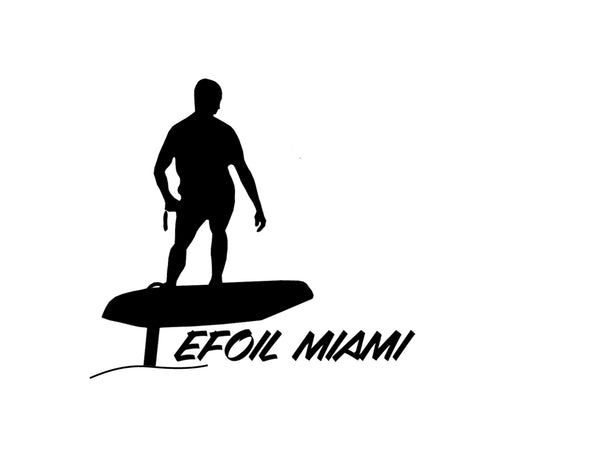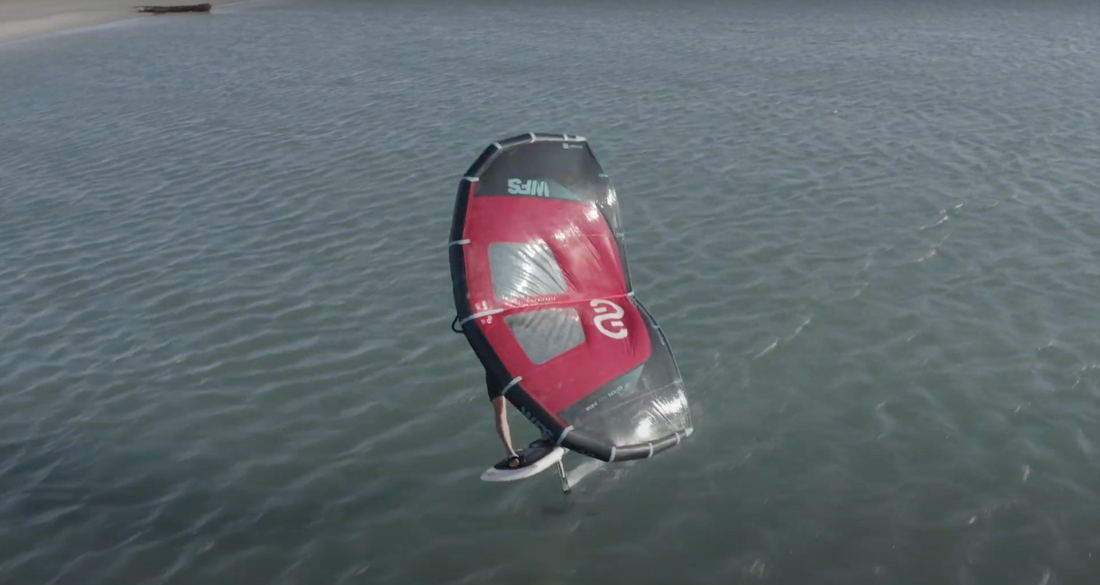Wingfoil for Absolute Beginners: Gear, Launch, and Your First Ride
From Kites to Wings: Why Wingfoiling Matters in Miami
I moved to Miami over a decade ago to teach kitesurfing full-time. I’d chase the wind all day, giving lessons whenever the breeze kicked up across Biscayne Bay. But like any local rider knows—Miami wind can be unpredictable.
So I started looking for a way to teach when there was no wind. That’s how I got into eFoils. The electric glide gave people a way to fly across the water without waiting on conditions.
Then wingfoiling came along—and it changed everything. It was lightwind friendly, safe, accessible, and unlike anything we’d seen before. Wingfoil sits perfectly between kiting and eFoiling. You don’t need lines, a boat, or a big learning curve—just a wing, a board, and a bit of wind.
Now, I get to share that freedom with both locals and visitors every week. Whether you’re curious about your first ride or looking for the best beginner gear, this guide will walk you through everything you need to know to start wingfoiling in Miami or anywhere with warm water and wind.

What is Wingfoiling and How Does It Work?
Wingfoiling—also called wing surfing or wind winging—is a new watersport where you ride a foil board while holding a handheld inflatable wing. There are no lines, no mast, and no kite overhead. You control the power directly with your hands as the wing catches the wind.
As you build speed, the hydrofoil beneath the board generates lift. That’s when the board rises above the surface—and suddenly you’re flying silently over the water, floating on what feels like air. No chop, no bounce—just glide.
It’s a blend of:
Windsurfing’s simplicity (no lines, no relaunch hassle),
Surfing’s feel (carving and cruising),
Kiting’s freedom (riding upwind, jumping, exploring long coastlines),
…but in a lighter, more beginner-friendly form.
Why Wingfoil is Perfect for Miami Conditions:
Works in 12–20 knot wind—our sweet spot
Easy to launch from flatwater spots like Crandon Park or Matheson Hammock
Minimal gear and fast learning curve
No deep-water relaunch like kiting—perfect for teaching in light breeze
Feels like eFoiling without a motor
Whether you're brand new or coming from another sport like surfing, paddleboarding, or kitesurfing, wingfoiling is intuitive and endlessly fun.

What gear do you need to start wingfoiling?
1. Wing (4 m–5 m for beginners)
Medium-sized wings (4 m–5 m) provide balanced power and control—great for learning in 15–20 knot winds
2. Board (100–150 L)
High-volume boards hold you up early, minimize falls, and let you focus on wing handling
3. Foil (low‑aspect, ~1600–1700 cm²)
Larger, low-aspect foils lift at lower speeds, making takeoff easier. Start with a 60–70 cm mast for stability
4. Safety Gear
Helmet, impact vest, leash, and a light wetsuit go a long way—even in Miami
Explore beginner wingfoil gear (insert link to gear package page).

What’s the best beginner wingfoil setup?
Bodyweight + 20 L rule for board volume
Pair a 4 m–5 m wing with a low-aspect foil (~1600 cm²) on a 60 cm mast
Bundle recommendations: Start with board/foil/wing + leash, vest, and helmet
Get Your First Wingfoil Setup Now
How do you launch and ride a wingfoil for the first time?
1. Ground School
Start on the beach—inflate wing, practice stance, power/shutoff drills
2. Kneeling Warm-Up
Begin kneeling in shallow water. Work on wing power and board balance before standing.
3. Standing & Gliding
Pop up feet-first, catch wind, and begin to foil. Use the wing to steer and gradually lift.
The “6 P’s” Method by Rygo.
Points of Contact: multiple body parts in contact with wing/board
Position: balanced foot stance and center of gravity
Patience: wait for wind and speed
There is also persistence, practice and place.
Learn more here - Read our full beginners guide here.

Beginner Wingfoil Safety Checklist and Water Rules
Before you ride, understand this: never sail farther than you're willing—or able—to swim back. That’s the golden rule of wingfoiling (and any wind-powered sport). Even with great gear and perfect weather, things can change fast.
Luckily, wingfoiling is one of the safest foiling disciplines when you follow a few core guidelines. The wing is inflatable (not dangerous like a kite), the board floats like a raft, and you’re in full control with no lines to tangle. But that doesn’t mean you can skip the fundamentals.
Wingfoiling Safety Basics for Beginners
Wind: 15–20 knots is your sweet spot
Too little wind and you’ll struggle to get going. Too much, and the wing gets overpowering fast—especially if you’re still figuring out stance and power control.
Leashes: Always use both
Attach a wing leash to your wrist and a board leash to your ankle or waist. This ensures nothing drifts away if you fall. It also prevents accidents for others in the water.
Conditions: Stay in beginner-friendly zones
Launch from areas with side-onshore winds (not offshore)
Avoid crowded swim zones and heavy boat traffic
Look for wide, flatwater areas like Biscayne Bay, Crandon Park, or Matheson Hammock in Miami
Never Ride Alone
Wingfoil with a buddy or stay in visual range of your instructor. Even experienced riders sometimes need help relaunching or returning to shore.
Skip the Big Waves (Until You’re Ready)
If you're not advanced, don’t chase swell. Wingfoiling in waves requires fast reflexes, proper technique, and confidence with foil pitch. Flatwater = faster progress and safer sessions.
Emergency Plan: Know how to self-rescue
Unlike kiteboarding, wing is much easier to get back in. But if you want to go the extra mile you can carry a whistle or your phone in a waterproof case. Note your launch landmark (especially on long downwinders. If in doubt, paddle in and deflate the wing to reduce drag.
Pro Tip: If you're unsure about a spot, watch someone more experienced ride it first. Don’t guess wind direction from a weather app—read the water, check flag angles, and always ask locals.
How long does it take to learn wingfoiling?
Most beginners can get up and riding a wingfoil in 6 to 10 hours of focused practice—often over just a few sessions.
Here in Miami, ideal conditions help speed up the process. Warm water, steady 12–20 knot winds, and flatwater launch spots like Crandon Park or Matheson Hammock create the perfect learning environment. Miami like all locations has it's nuances. We have a full guide on this topic you can read here.
What You’ll Learn in Each Session:
Day 1: Learn wing handling on land and balance on a board
Day 2–3: Ride on your knees, then stand and start gliding
By Session 4+: You’re foiling steadily and riding upwind
The key is consistency. Short, focused sessions with the right gear and instruction go a long way. Some students get up on foil their very first day, especially with private coaching or prior board sport experience (like kiting or snowboarding).
Pro Tip: Lighter winds may slow progress, while gusty winds or rough chop make learning harder. That’s why our instructors always match gear size and lesson timing to the conditions.
Where can you learn to wingfoil near you?
eFoil Miami offers private & group lessons out of Biscayne Bay, using Eleveight gear and launching from top spots like Key Biscayne and Matheson Hammock.
Find a Lesson or Clinic Near You
FAQs for absolute beginner wingfoilers
Q: What is wingfoiling in simple terms?
A board lifts you above the water using a handheld wing.
Q: Do I need wind to wingfoil?
Yes—12–25 knots is best for beginners Check out our beginners guide for Miami.
Q: Is wingfoiling easier than kiteboarding?
More straightforward—no lines, less gear, quicker safety learning curve.
Q: What size gear should a beginner get?
Foil: 1600+ cm²; Wing: 4 m–5 m; Board: 100–150 L.
Q: How much does it cost to start?
Entry-level setups: USD 2K–3.5K.

Ready to get started?
Wingfoiling is within reach—and in Miami, with predictable breeze, flat water, and expert instruction, you can literally fly your first session.
-
Gear: Lightweight, stable setups built for learners
-
Launch: Clear progression from ground drills to gliding
-
Support: Safety-first approach on scenic Biscayne waters
Join us and learn to ride — check out gear packages or book a private lesson and be foiling in no time.
Quick Resources

Written by Ryan "Rygo" Goloversic and Chris Bobryk.
Rygo is a globally recognized kiteboarder, digital marketing expert and an advocate for wakestyle kiteboarding. The founder of Rygo Labs an agency specializing in SEO and SGE for websites. He's An avid waterman, he's passionate and knowledgeable about all things watersports from wing foil to wake. When he's not writing articles, you can catch him competing on the KPLxGKA world tour or grinding it out in the gym.

